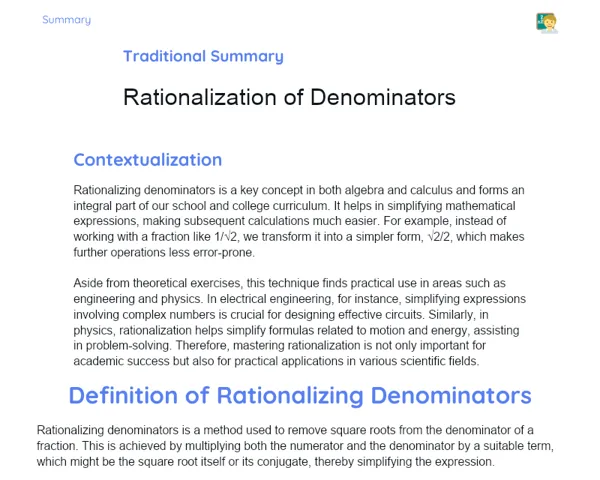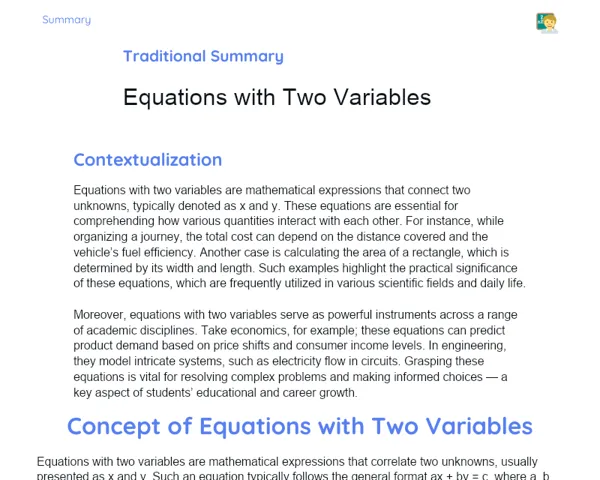Summary Tradisional | Matrix: Classifications
Contextualization
Matrices are a basic mathematical tool that finds wide use in areas such as engineering, computer science, economics, and physics. They help in organising and manipulating data systematically, thereby making it easier to tackle complicated problems. In our daily life, matrices are used in creating computer graphics, analysing linear systems in engineering, and even in modeling economic scenarios.
A good grasp of the various types of matrices is important for mastering these applications. For example, identity matrices, null matrices, singular matrices, and symmetric matrices each have unique properties that serve different purposes. The identity matrix, for instance, plays a key role in matrix multiplication, whereas the null matrix is important as the additive identity. Singular matrices are notable as they do not have an inverse, which can be critical when solving linear systems. Similarly, symmetric matrices often feature in the analysis of physical systems and optimisation problems.
To Remember!
Identity Matrix
The identity matrix is a special square matrix where all the elements along the main diagonal are 1, and all other elements are 0. It is usually represented by I and has a very important property: multiplying any matrix by the identity matrix yields the original matrix. This is much like how multiplying by 1 in ordinary arithmetic leaves a number unchanged.
This matrix is central to many mathematical operations, especially when solving systems of linear equations and in matrix theory. For example, while solving an equation like Ax = b (where A is a matrix and b is a vector), we often use the identity matrix to help find the inverse of A (if it exists), which in turn simplifies the solution process.
In addition, the identity matrix finds applications in various fields such as computer graphics for performing geometric transformations. It also plays a key role in defining and understanding concepts like eigenvalues and eigenvectors in linear algebra.
-
A square matrix with 1s on the main diagonal and 0s elsewhere.
-
Serves as the neutral element in matrix multiplication.
-
Used in solving systems of linear equations and in various areas of matrix theory.
Null Matrix
A null matrix is one in which every element is 0. It can be of any size, provided all the entries are zero. Commonly denoted by 0, this matrix acts as the additive identity, meaning that when you add it to any other matrix, the result remains unchanged.
This property makes the null matrix important in many mathematical operations. Just as 0 is the identity in addition for real numbers, the null matrix serves the same purpose in matrix addition. This makes it very helpful in both theoretical concepts and practical applications, such as in linear algebra and matrix computations.
Moreover, the null matrix finds its use in areas like signal processing and data analysis, where it can represent missing data or serve as an initial value in algorithms that work with matrices.
-
A matrix in which every element is 0.
-
Acts as the additive identity in matrix addition.
-
Used in many mathematical operations and practical setups.
Singular Matrix
A singular matrix is a square matrix that does not possess an inverse. This occurs when the matrix’s determinant turns out to be zero. In linear algebra, this concept is very significant since it determines whether a matrix can be inverted. If a matrix is singular, it cannot be used in operations that require finding an inverse.
Detecting a singular matrix is crucial in several mathematical problems and practical scenarios. For instance, in solving systems of linear equations, the presence of a singular matrix indicates that the system either does not have a unique solution or its equations are linearly dependent.
Singular matrices also play a critical role in fields like engineering and computer science, where matrix inversion is a common requirement. Hence, it is always advisable to check for singularity before attempting to compute the inverse.
-
A square matrix that does not have an inverse.
-
Its determinant is zero.
-
Important when solving systems of linear equations and for various practical applications.
Symmetric Matrix
A symmetric matrix is a square matrix that remains the same when its rows and columns are interchanged; in other words, it equals its transpose. This means that the element at the i-th row and j-th column is the same as that at the j-th row and i-th column. The property of symmetry is significant and shows up frequently in different branches of mathematics and its applications.
Symmetric matrices are pivotal in the study of linear systems and matrix theory. One of their special features is that all their eigenvalues are real numbers, which makes them particularly useful in optimisation problems and numerical methods.
Besides, symmetric matrices are used in various fields including engineering, physics, and computer science. For example, in engineering, they are instrumental in analysing structures and systems, while in computer science, they are utilised in image processing and computer graphics algorithms.
-
A square matrix that is equal to its transpose.
-
The element at position a(i,j) equals the element at a(j,i) for every i and j.
-
Key in the analysis of linear systems, optimisation problems, and various practical applications.
Key Terms
-
Identity Matrix: A square matrix with 1s on the main diagonal and 0s elsewhere.
-
Null Matrix: A matrix of any dimension where every element is 0.
-
Singular Matrix: A square matrix that does not have an inverse, meaning its determinant is zero.
-
Symmetric Matrix: A square matrix that is equal to its transpose, meaning a(i,j) = a(j,i).
Important Conclusions
In today’s lesson, we explored different types of matrices, namely the identity, null, singular, and symmetric matrices. Each type carries distinct properties that make them suitable for different mathematical and practical contexts. A clear understanding of these classifications is vital when tackling complex problems, whether in academic studies or in professional fields like engineering, computer science, and economics.
For instance, the identity matrix is indispensable in matrix multiplication as it acts like the number 1 in the usual multiplication. The null matrix is valuable as the additive identity in matrix addition. On the other hand, singular matrices, which lack an inverse, alert us to potential issues when solving systems of linear equations. Lastly, symmetric matrices, with their distinct properties, are often used in optimisation and numerical analysis.
The insights gained from this discussion not only deepen our understanding of matrices but also pave the way for further exploration in both academic and professional spheres. I encourage everyone to delve deeper into the subject and continue experimenting with these concepts in various practical scenarios.
Study Tips
-
Review the class examples and try solving extra problems related to matrix classification.
-
Make use of online resources like educational videos and interactive simulators to better visualise matrix operations.
-
Organise study groups to discuss different types of matrices and share varied methods and solutions.



